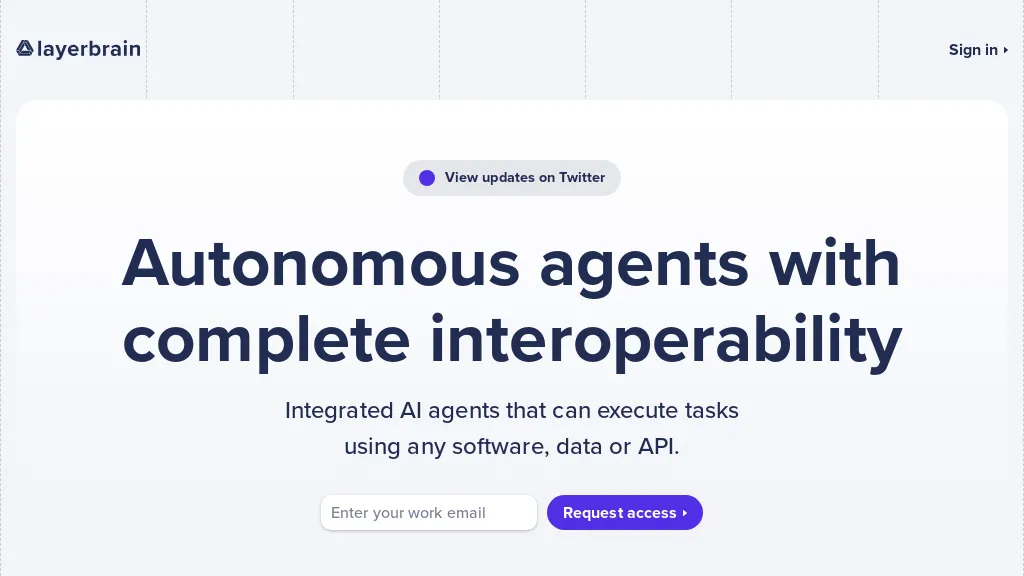What is Layerbrain?
Layerbrain is an advanced AI tool that provides a way for autonomous agents to achieve seamless interoperability, communicating with, sharing data with, and working in collaboration with other agents. Automation of tasks and processes powered by AI agents operating within your workflow and empowered by software, data, and APIs becomes possible by use of Layerbrain.
What’s unique about Layerbrain is its effectiveness and efficiency in the manner it carries out tasks, from big dataset processing to complex computations. Its smart algorithms ensure optimum performance with accurate results. More important, Layerbrain updates you in real time, from different sources, including social network platforms like Twitter. The ability to adapt quickly could be made possible through Layerbrain, a generalized tool for empowering autonomous agents to seamlessly interact.
Key Features of Layerbrain
Key features of Layerbrain include:
-
Autonomous Communication:
Allows agents to communicate with each other without interference from any human. -
Data Exchange:
Agents are capable of seamless data exchange that promotes their collaboration. -
Collaboration:
Ensuring teamwork between AI agents improves overall efficiency in the execution of tasks. -
Task Automation:
Repetitive and complex tasks are handled, thereby saving time and reducing the chances of human error. -
Efficient Processing:
It can handle volumes of data and perform complex calculations with precision. -
Real-time Updates:
It provides for instant updates from any number of sources, through which timely responses can be instituted and changes effected.
Advantages of Using Layerbrain
The advantages with the use of Layerbrain include increased efficiency, cost-effectiveness of operations, and higher degrees of accuracy in task performance. Its value proposition relates to the support of real-time communication and data exchange, thereby adding value to the vast pool of industries and sectors.
Layerbrain Use Cases and Applications
It helps DevOps engineers, automation professionals, AI developers, business analysts, data scientists, and software architects. A few examples of the things that can be done using Layerbrain include:
-
DevOps Engineers:
Automate their deployment and monitoring processes, hence assure continuous delivery and integration. -
Automation Specialists:
Automate repetitive tasks, hence freeing up the teams for work on strategic initiatives. -
AI Developers:
Extend the capabilities of the AI models by integrating these into one cohesive system. -
Business Analysts:
Analyze real-time data for actionable insights that drive informed decisions. -
Data Scientists:
Efficiently manage and process large datasets, enabling better predictive modeling. -
Software Architects:
Create robust systems that tap into the power of independent agents delivering more value.
How to Use Layerbrain
Using Layerbrain is quite simple. Here is a step-by-step guide:
-
Setup:
Set up Layerbrain and configure it according to your needs. -
Agent Integration:
Integrate your autonomous agents with the Layerbrain platform. -
Task Definition:
Identify tasks that need automation and assign a suitable agent to execute the responsibility. -
Performance Monitoring:
Consume real-time updates and monitor progress and performance of your agents. -
Optimization:
This is somewhat a continuous process where you refine your setup based on insights and data collected.
For best practices, please ensure that agents are set up correctly and you use all of the options in Layerbrain. The user interface is intuitive, so it is easy to navigate.
Overview of Layerbrain
Layerbrain works with advanced AI algorithms and models for seamless communication between autonomous agents in order to share data. Underlying the technology are sophisticated machine learning methods that optimize the execution of tasks and the processing of data in the flow. The general workflow is as follows:
-
Initialization:
Agents are created and set up on the Layerbrain platform. -
Task Assignment:
Agents are assigned to handle tasks based on predefined parameters and criteria. -
Execution:
Agents perform tasks autonomously by communicating and collaborating if needed.
Continuous monitoring and adjustments are thus allowed, as it is possible to get real-time updates through the system.
Layerbrain Pros and Cons
In every tool comes a few pros and cons associated with it. Given below are some of them in the case of Layerbrain:
Pros
- Smoother efficiency and productivity
- Possible real-time data and updates
- Ease of communication and collaboration between agents
- Scalability: handles a large volume of data
Cons
- Initial set-up and configuration may be overwhelming for some users
- Monitoring extensively to continuously optimize performance
- Potential for dependency on the AI tool limiting flexibility
User reviews generally mention the efficiency of the tool and real-time capabilities, although some users do mention that the initial setup can be complex.
Conclusion about Layerbrain
In a nutshell, Layerbrain is a powerful AI interoperability platform that empowers autonomous agents by automating tasks and efficiently processing data. Some major traits of the platform are autonomous communication, data exchange in real-time, and updates, which helps it to be included as an asset to various industries. Despite a number of challenges in initial setup, the benefits weigh heavier. More updates and improvements are likely in the future.
Layerbrain FAQs
Q: What is Layerbrain?
A: Layerbrain is an AI tool designed to allow autonomous agents in communicating, exchanging data, and working with them seamlessly.
Q: Who are the users?
A: It is utilized by DevOps engineers, automation specialists, AI developers, business analysts, data scientists, and software architects.
Q: Key features of Layerbrain?
A: Key features include autonomous communication, the exchange of data, automation of tasks, efficient processing, and updating in real time.
Q: How does Layerbrain work?
A: Layerbrain uses advanced AI algorithms and models to enable the agents of two or more agents to communicate with each other, easily sharing data in real time.
Q: Layerbrain Pros and Cons
A: Pros are increased efficiency, real-time update; Cons are it can be complex to set up initially, and one may get dependent on the tool.

